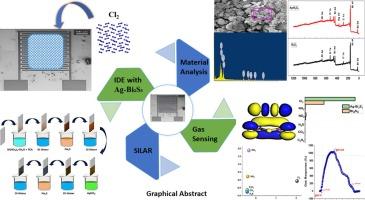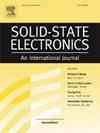Influence of Ag-Bi2S3 nanocomposites for highly sensitive and selective Cl2 gas sensors: Synthesis, characterization, and gas sensing performance
IF 1.4
4区 物理与天体物理
Q3 ENGINEERING, ELECTRICAL & ELECTRONIC
引用次数: 0
Abstract
The gas sensing capabilities of Bi2S3 chalcogenide have been actively enhanced and explored revealing its potential for high-performance Cl2 gas detection under different environmental conditions and sensing configurations. This work successfully synthesized Bi2S3 material via the SILAR method and further enhanced its sensing capabilities by fabricating Ag-Bi2S3 nanocomposite. Both pristine Bi2S3 and Ag-Bi2S3 nanocomposite films underwent comprehensive characterization utilizing techniques such as FESEM, EDX, XRD, XPS, and RAMAN to analyze their morphological, structural, and chemical properties. Gas sensing capabilities were evaluated across a temperature range of 26–350 °C and varying Cl2 gas concentrations (0.1–50 ppm). The findings reveal that the Ag-Bi2S3 sensor demonstrates notably superior Cl2 sensing response, particularly at an operational temperature of 150 °C, suggesting its promising potential for Cl2 detection. The LOD has been calculated for Ag-Bi2S3 sensor showing results of 0.150 better than pristine Bi2S3. HOMO-LUMO and PCA analysis for sensors has been studied to understand their capabilities with different gas sensing.

Ag-Bi2S3 纳米复合材料对高灵敏度和选择性 Cl2 气体传感器的影响:合成、表征和气体传感性能
Bi2S3 Chalcogenide 的气体传感能力得到了积极的提升和探索,揭示了其在不同环境条件和传感配置下进行高性能 Cl2 气体检测的潜力。这项研究通过 SILAR 方法成功合成了 Bi2S3 材料,并通过制备 Ag-Bi2S3 纳米复合材料进一步增强了其传感能力。利用 FESEM、EDX、XRD、XPS 和 RAMAN 等技术对原始 Bi2S3 和 Ag-Bi2S3 纳米复合薄膜进行了全面表征,分析其形态、结构和化学特性。在 26-350 °C 的温度范围和不同的 Cl2 气体浓度(0.1-50 ppm)下,对其气体传感能力进行了评估。研究结果表明,Ag-Bi2S3 传感器的 Cl2 传感响应明显优于其他传感器,尤其是在 150 ℃ 的工作温度下,这表明它在 Cl2 检测方面具有很大的潜力。计算得出的 Ag-Bi2S3 传感器的 LOD 值比原始 Bi2S3 高 0.150。对传感器的 HOMO-LUMO 和 PCA 分析进行了研究,以了解它们对不同气体的传感能力。
本文章由计算机程序翻译,如有差异,请以英文原文为准。
求助全文
约1分钟内获得全文
求助全文
来源期刊

Solid-state Electronics
物理-工程:电子与电气
CiteScore
3.00
自引率
5.90%
发文量
212
审稿时长
3 months
期刊介绍:
It is the aim of this journal to bring together in one publication outstanding papers reporting new and original work in the following areas: (1) applications of solid-state physics and technology to electronics and optoelectronics, including theory and device design; (2) optical, electrical, morphological characterization techniques and parameter extraction of devices; (3) fabrication of semiconductor devices, and also device-related materials growth, measurement and evaluation; (4) the physics and modeling of submicron and nanoscale microelectronic and optoelectronic devices, including processing, measurement, and performance evaluation; (5) applications of numerical methods to the modeling and simulation of solid-state devices and processes; and (6) nanoscale electronic and optoelectronic devices, photovoltaics, sensors, and MEMS based on semiconductor and alternative electronic materials; (7) synthesis and electrooptical properties of materials for novel devices.
 求助内容:
求助内容: 应助结果提醒方式:
应助结果提醒方式:


